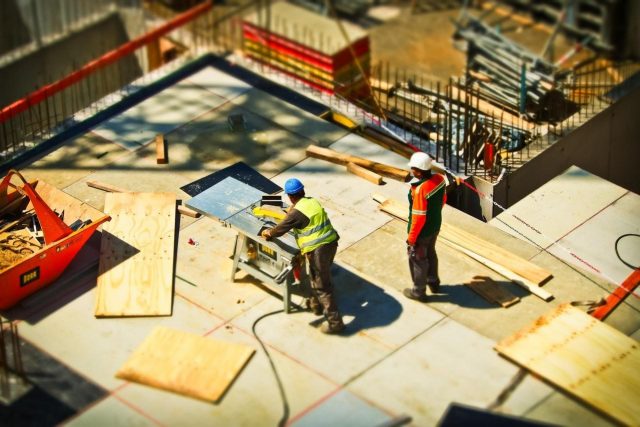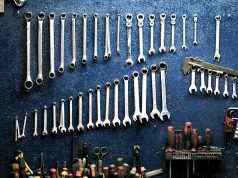
Air compressors are popular pieces of equipment on many construction sites across the UK. You might be familiar with them being used for their high efficiency and output, but have you ever sat back and wondered exactly why they’re so useful in the construction industry? Below we’ll explore the benefits an air compressor can bring to your construction site and why many construction companies are opting to use them.
What is an air compressor?
An air compressor is a machine that stores compressed air for later use. The air compressor converts fuel or electricity into potential power (pressurised air), which can be used to power things like pneumatic tools on a construction site.
How does the construction industry use air compressors?
Air compressors are extremely useful on construction sites due to their high output and efficiency. A variety of power tools can be used on-site when a compressor is used to power them, such as pneumatic drills, power hammers, saws, compactors and much more. The advantages of having air compressors on a construction site are that tools don’t require large motors or heavy batteries as they run off an air compressor, which converts energy from fuel or electricity into kinetic energy, driving the energy from the compressor to the power tools. This is useful as it can be used to power each device as required. Air compressors tend to run quietly too, meaning it cuts down on noise pollution (which can be a great advantage if you’re working in a remote area).
Types of air compressors
There are several different air compressors available on the market for use in the construction industry, all with their own advantages and disadvantages.
There are two main types of air compressors to choose from – positive displacement or dynamic displacement. The main difference between the two air compressors is how their internal mechanisms work to compress the air.
Positive displacement compressors reduce the size of air with rotors or pistons, whereas dynamic displacement compressors speed up the air, moving it at high velocity before restricting airflow to create increased pressure.
To find out more about the different types of air compressors visit AMS Compressor.
Dynamic displacement compressors
One of the main advantages of dynamic displacement compressors is that they’re often oil-free, which is great if you’re looking to use greener ways of working. The two most common types of dynamic compressors you will see are axial and centrifugal.
Axial compressors aren’t commonly used in construction projects as they’re costly. You’ll more likely find one of these on a ship or plane as they can generate an incredible amount of horsepower. You’re more likely to find a centrifugal compressor on a large-scale construction site such as a chemical plant or manufacturing centre as they can reach around 1,000 horsepower.
Positive displacement compressors
The great thing about positive displacement compressors is they’re relatively low to run, their components are easy to manufacture, and they offer high-efficiency rates making them great for a variety of construction jobs. The two most common types of positive displacement compressors you will see are rotary screw and reciprocating compressors.
Rotary screw compressors are a favourite amongst many in the construction industry as they are straightforward to maintain. They feature an internal cooling system that can be either lubricated with oil or run oil-free. Because of their internal cooling system, these air compressors are designed for continuous use and can generate power of up to 350 horsepower. Unlike rotary screw compressors, the reciprocating compressor isn’t intended for constant use, which is why you will only find them at smaller construction projects such as home renovations and for metal or woodwork.
How often do air compressors need maintenance?
Poorly maintained air compressors can cost your business a significant amount of money, so it’s always important to get proper maintenance. Minor problems can quickly develop into significant ones, so preventative maintenance is critical. At AMS compressor services, we suggest servicing your air compressor once a year, but it could be as frequent as every six months, depending on how frequently your compressor is used. Find out more about Air Compressor Services here https://amscompressors.co.uk/air-compressor-services/.
What type of maintenance is needed with compressors?
Routine maintenance should be carried out to ensure compressors are in full working order. Below are five common maintenance areas with air compressors:
- Clean the intake filter – clean and clear valves are essential for your compressor to run correctly. Blocked valves can lead to severe issues later, so you should always clean the valves every 12 weeks.
- Drain the tanks – it’s essential to drain the moisture tanks regularly as leaking or excess moisture can damage your machine and lead to significant problems.
- Change the oil – just like your car, an air compressor that uses oil will need it changing from time to time. It’s recommended you change it every 2,000 hours of use or every year.
- Tighten the nuts and bolts – nuts and bolts can come loose through vibrations from the compressor. Ensure you check these once a month and tighten them where needed.
- Service your air compressor – compressors need regular servicing to ensure maximum run time, so getting regular services is key to making your machine last longer.
Conclusion
Like any other piece of equipment that you use regularly, you need to ensure your air compressor is maintained to the highest standards to prevent serious problems from arising.













